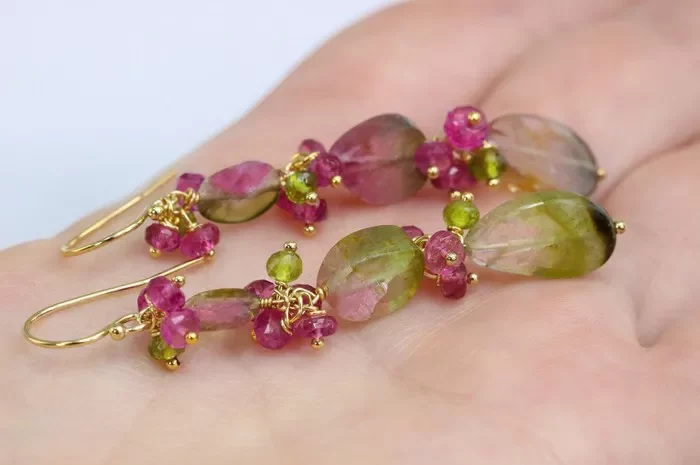Gemstones are known for their unique beauty, rarity, and diverse physical properties. Among the many gemstones available, pink tourmaline and diamond stand out due to their distinct characteristics and uses. One of the most notable differences between these two gemstones is their hardness. In this article, we will explore the reasons behind this significant difference in hardness, providing a detailed introduction to pink tourmaline and diamond, along with a popular science explanation of hardness and its implications for gemstone use and care.
Understanding Pink Tourmaline
1. What is Pink Tourmaline?
Pink tourmaline is a variety of the tourmaline gemstone, which belongs to the borosilicate mineral group. Tourmaline is characterized by its complex chemical composition and its unique crystalline structure. Pink tourmaline, specifically, owes its color to the presence of manganese and other trace elements within its crystal lattice. This mineral is renowned for its vibrant pink hues, which can range from soft, pastel pinks to deeper, more intense shades.
2. Physical Properties and Hardness
Pink tourmaline is a relatively hard gemstone, ranking between 7 and 7.5 on the Mohs scale of hardness. This scale measures a mineral’s resistance to scratching or abrasion, with a higher number indicating greater hardness. Tourmaline’s hardness makes it suitable for use in jewelry, as it can withstand the wear and tear of daily activities. However, it is still softer than some other gemstones, such as diamonds, which have a hardness of 10 on the Mohs scale.
The hardness of a gemstone is influenced by its crystal structure and chemical composition. Pink tourmaline’s hardness is due to the strong bonds between its silicon, oxygen, aluminum, boron, and other constituent atoms. These bonds create a stable, rigid crystal structure that resists scratching and wear.
Understanding Diamonds
1. What are Diamonds?
Diamonds are the hardest naturally occurring mineral on Earth, with a hardness of 10 on the Mohs scale. They are composed purely of carbon atoms arranged in a tetrahedral crystalline structure. This unique structure gives diamonds their unparalleled hardness and brilliance.
2. Physical Properties and Hardness
Diamonds’ hardness is a result of their carbon atoms being arranged in a highly organized, tetrahedral lattice. Each carbon atom is covalently bonded to four other carbon atoms, creating a network of strong, rigid bonds. This arrangement makes diamonds extremely resistant to scratching, wear, and compression.
In addition to their hardness, diamonds are also known for their optical properties, including their high refractive index and dispersion. These properties contribute to diamonds’ famous sparkle and brilliance, making them highly valued in jewelry and other applications.
The Science Behind Hardness
1. What is Hardness?
Hardness is a measure of a material’s resistance to scratching or indentation when a harder material is pressed against it. The Mohs scale of hardness is a qualitative scale that ranks minerals based on their ability to scratch or be scratched by other minerals.
2. Factors Influencing Hardness
The hardness of a mineral is determined by its crystal structure and chemical composition. Minerals with strong, rigid bonds between their atoms tend to be harder than those with weaker bonds. Additionally, the arrangement of atoms within the crystal structure can also affect hardness. For example, minerals with closely packed atoms tend to be harder than those with more loosely packed atoms.
Implications for Gemstone Use and Care
1. Durability in Jewelry
The hardness of a gemstone is a critical factor in determining its suitability for use in jewelry. Harder gemstones, such as diamonds, are more resistant to scratching, wear, and chipping, making them ideal for use in rings, bracelets, and other pieces that are subject to frequent wear and tear. Softer gemstones, such as pink tourmaline, may require more careful handling and maintenance to prevent damage.
2. Care and Maintenance
The care and maintenance of gemstones vary depending on their hardness. Harder gemstones, such as diamonds, can be cleaned using more abrasive methods, such as steam cleaning or ultrasonic cleaners. Softer gemstones, such as pink tourmaline, may require gentler cleaning methods, such as using a soft cloth and warm water, to avoid scratching or damaging the surface.
Additionally, the hardness of a gemstone can affect its ability to withstand heat and chemicals. Harder gemstones, such as diamonds, are more resistant to these factors than softer gemstones. Therefore, it is important to consider a gemstone’s hardness when determining its suitability for use in jewelry or other applications that may expose it to heat or chemicals.
Conclusion
In conclusion, the difference in hardness between pink tourmaline and diamonds is due to their unique crystal structures and chemical compositions. Diamonds, with their tetrahedral crystalline structure and strong covalent bonds, are the hardest naturally occurring mineral on Earth, making them highly resistant to scratching, wear, and compression. Pink tourmaline, while still a relatively hard gemstone, is softer than diamonds and may require more careful handling and maintenance to prevent damage. Understanding the hardness of gemstones is crucial for selecting the right gemstone for jewelry and other applications, as well as for ensuring their long-term durability and beauty.
Related topic:
- Understanding the Suitability of Wrists for Wearing Black Tourmaline Jewelry
- How to Activate Black Tourmaline?
- How to Identify the Quality of Tourmaline


